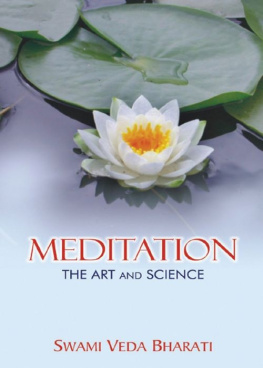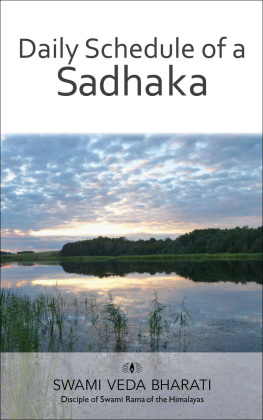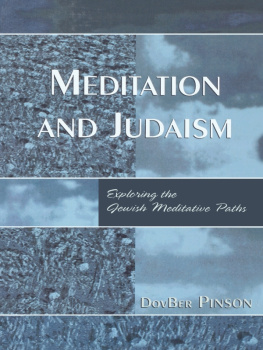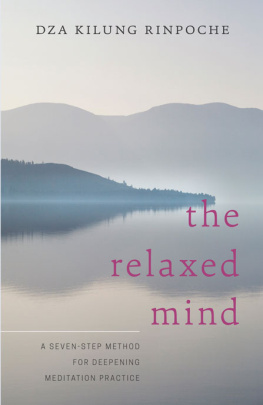
Table of Contents
MEDITATION
THE ART AND SCIENCE
SWAMI VEDA BHARTI

CONTENTS
Preface vii
Part One Basics of Meditation 1
1. History of Meditation 3
2. Beginning Meditation 21
3. Knowing the Himalayan Tradition 39
Part Two Practicing Meditation 51
1. When to Meditate? 53
2. The Seat of Meditation 61
3. Feelings while Meditating 75
Part Three Persona of a Meditator 81
1. Yogis Schedule 83
Part Four Psychological Aspects of Meditation 97
1. The Gift of Meditation 99
2. Meditation for Others Sake 105
3. Praying through Meditation 115
Part Five Advanced Meditation 127
1. Subtleties in Meditation Practice and Philosophy 129
2. Group Meditation 147
3. Different Kinds of Advanced Meditation 151
4. Common Meditation Practices in Other Religions 165
Part Six The Poetry of Yoga 195
1. What is Yoga? 197
2. Yoga is the Message 199
Swami Veda Bharti, 2008
ISBN: 978-81-8328-115-7
All rights reserved. No part of this book may be reproduced, stored in a retrieval system or transmitted in any form or by any means electronic, mechanical, photocopying, recording or otherwise without the prior permission of the author and publisher.
Published by
Wisdom Tree
4779/23, Ansari Road
Daryaganj
New Delhi-110002
Ph .: 23247966/67/68
Published by Shobit Arya for Wisdom Tree; edited by Manju Gupta; designed by
Kamal P. Jammual; typeset at Marks & Strokes, New Delhi-110002 and printed at
Print Perfect, New Delhi-110064
PREFACE
Meditation is where art and science converge. It is a vision, an inspiration and an intuition. It arrives on the screen of a visionary mind from sources within that are beyond calculations. Only after they have arisen from within can we look at them and analyse their dimensions. It is born like a peacocks multi-hued feathers; they are first concealed in the egg. Break open the egg and you will not see the colours but they are there in their intangible form till they manifest themselves. Thus it is with meditation intangible like the peacock feathers in the egg, like the million leaves of a tree in the seed, like the bloom of the roses in the twigs that are initially planted.
It is not that an artist can produce his work without use of science. The ink, the palette and the canvas cannot be produced without knowledge of science. An understanding of the wavelengths of light that make up colour is based on science. But without the wholistic intuitive vision in the artists mind, the ink, palette, canvas and the colour will not produce a masterpiece. That is also why a theorem has to be symmetrical, elegant and beautiful.
viii  Meditation
Meditation
One may calculate, count and measure the extent of the measurables in the works of art after they have shown their visages to us. What comes before that showing of themselves is art; the post facto analysis is science.
So it is with meditation.
Why should one sit in a certain posture; how will that benefit the musculature and the internal organs; why one should breathe diaphragmatically; what happens in our bodies and personalities when causes of tension and stress are present; how do yoga relaxation methods reduce or altogether eliminate stress; what neural, electrical or hormonal messages are sent forth into the body to alter its reaction to causes of stress these and many others are the scientific components of the teachings of meditation.
While one is meditating, what brain waves are being produced; what is the level of skin resistance; what changes occur in the heart and pulse rate these observations on EEG, EMG and resperometre, etc. are also part of the science of meditation.
But the intention to meditate; what one does intuitively, inwardly, in meditation; how one cultivates the spirit of adventure and dives deeper and deeper into the fathoms of the mind-ocean; above all, the nameless serenity, a feeling that one experiences these are all parts of the art of meditation.
Art is the soul and science is the body of the aesthetic or psychical experience. Art is the poem; science is the grammar. The two are inseparable. Hence we have said elsewhere, science is the most beautiful poem that has ever been written. We may add, art is the most beautiful manifestation of scientific creativity. In meditation they are merged together; the science of art, the
Preface  ix
ix
art of science; the beauty of precise measurement, the measure of aesthetic depth; the two hemispheres of the brain absolutely balanced and in communication with each other in perfect alignment.
When the cerebral hemispheres are in perfect alignment, the two nostrils breathe as one and the awareness, unified, enters the sushumna stream. Here the art and science of meditation reaches its conclusion the total liberation of human spirit from all limitations.
Then our consciousness wordlessly sings out poornam. Whole. Complete. Indivisible. Il-limitable. Perfect Infinitude. Perfect knowledge of perfect beauty. Perfect beauty of perfect knowledge.
Poorna-saundarya-jnanam, Poorna-jnana-saundaryam.
May you see the beauty of the self in your current embodiment.
Swami Veda Bharati Swami
Rama Sadhakagrama
Rishikesh
PART ONE

BASICS OF MEDITATION
CHAPTER 1
HISTORY OF MEDITATION
Meditation is self-regulation of ones attention in the here and now. The aim of meditation is to still the mind and take it away from the daily happenings to focus on a pre-selected object. This helps in minimising distraction and focusing on the chosen object. Thus, in short, meditation entails mindfulness and concentration which help the mind from wandering around and focus on a subject of ones choice.
Meditation has three levels: the preparation, the process and the ultimate end. The last two are known as samadhi. The last of the samadhis, the ultimate end, the ultimate goal, is that in which the mind plays no part because the mind is left behind. It is beyond the mind. Here we must very carefully distinguish between the mind and the self. In the tradition of yoga when we speak of self, we do not refer to the visible personality. We mean atman, the self, that is a particular force called the life force, and a particular force called consciousness force, otherwise known in Sanskrit as jiva. Chit means force of consciousness and is beyond the mind. It controls the mind and directs the mind. It is the seat of awareness and will power. That is the highest samadhi, when one truly discovers the non-qualitative self, non-quantative self, and non-conditional self.
Below that is the lower samadhi in which the mind plays a part, and that is the one-pointedness of the mind. The word one- pointedness needs to be understood. It does not mean the mind pointed at something. One of the problems in the entire history of Western philosophy and psychology has been that it has not yet, in all the twenty-six centuries of its history, arrived at an agreed upon definition of the word mind. With all the studies in psychology and other disciplines, the word mind has not yet been defined. And that is where the philosophical systems of India differ. We begin with the definition of the mind. I have spoken of this self as a force; the mind also is a particular type of force-field. It may be a weak force-field or a strong force-field. It may be a scattered one or it may be a concentrated one. And this is a force-field, which is centred and not spread out. When the entire mind is concentrated into a single point and that mind becomes a point, like the first brilliant point of light from which the whole universe emanates, when your entire mind force becomes in itself a point, then it is called a one-pointed mind.
Next page










 Meditation
Meditation ix
ix